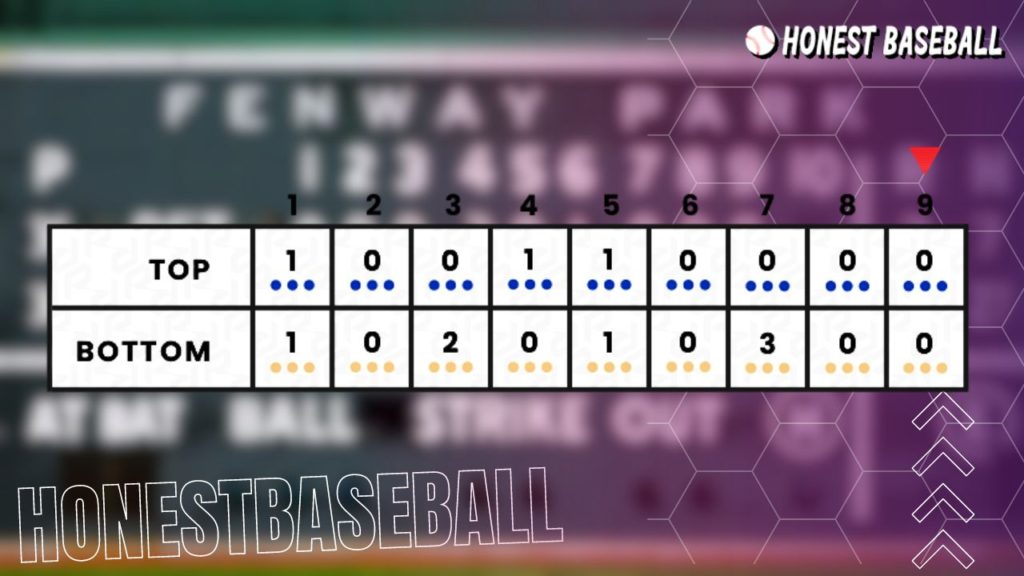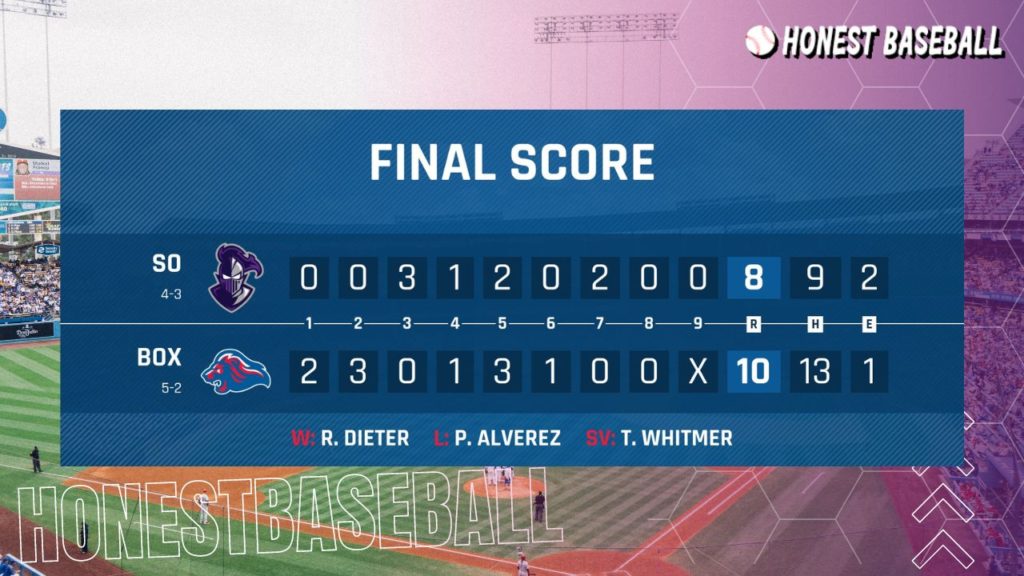Whether watching live or from home, baseball scoreboards are inevitable to learn ongoing scores and stats. But without knowing how to read a baseball scoreboard, you can’t enjoy the full intensity of the game.
Baseball scoreboards serve as a visual representation of the game’s progress. It allows fans to stay updated with the current score, inning, outs, strikes, and various player statistics.
Not only that, but MLB scoreboards also showcase various interesting features like other ongoing out-of-the-town scores, ranking, game time, etc.
Understanding the abbreviations and symbols displayed on these scoreboards enhances the overall baseball-watching experience.
In this article, I’m gonna share the meaning of all these signs and symbols so that you don’t need to shame yourself next time hanging inside a ballpark or watching a match with your buddies.
Understanding the Basics: What Do the Numbers Mean?
Most scoreboards feature three elements: score, inning number, and outs totals. Before diving deeper into understanding a baseball scoreboard, you need to learn a bit about these baseball terms.
Score System

The score section, located in the center of a scoreboard indicates the number of runs scored by each team.
Typically the home team’s score will appear at the bottom while the visiting team’s score will appear on top.
For example, if the home team scored 3 runs and the visiting team scored 2 runs the scoreboard will display “Home: 3 | Visitor: 2.”
However, it’s important to note that depending on the specific scoreboard system being used there may be variations in color coding and design.
Game Innings

Another commonly used metric on a scoreboard is match innings. An inning refers to one of nine sections of a match during which teams alternate between batting and defending.
More specifically, each inning represents a division of the game into nine sections where both teams have an opportunity to bat and play defense during their respective innings.
The scoreboard displays these innings starting from 1 and going up to 9. If a game extends beyond the regulation nine innings due to extra innings then numbers greater than 9 will be shown on the scoreboard.
Player Outs
Outs in baseball are an integral component, as they indicate how many batters have been sent back to their dugout.
Each team receives three outs per inning for defense; on the scoreboard, they appear as numbers between 0 and 2. Once an inning concludes with three outs being recorded against either team, play shifts to another half.
Abbreviations and Symbols of Baseball Scoreboards
Baseball scoreboards provide more than just numbers. You’ll see various abbreviations and symbols that provide concurrent insights about the ongoing match. Here are the most frequently seen ones:
Runs (R)

Perhaps, the most common and exciting term on the scoreboard is the “R”, which stands for Runs.
Every time the batting team successfully crossed home plate and earned points, you’ll see it’s changing.
In terms of prominence and thrill, there is perhaps no other term on the scoreboard that surpasses “R” which stands for Runs.
Whenever the batting team successfully completes a circle around the bases and accumulates points, you’ll see it’s changing.
Hits (H)
Hits refer to the number of successful contacts made by the batter, resulting in reaching a base without any errors by the fielding team. The scoreboard displays the total number of hits using the abbreviation “H.”
Errors (E)
To define any errors of the defensive team, the scoreboard shows “E.” It occurs when defensive players fail to make plays that average players should have made, allowing an opposing player to safely reach base. Errors allow the batter or baserunners to advance more bases than they should.
Balls (B) and Strikes (S)
The pitcher throws several pitches that could end in either a ball (B) or strike (S). It’s considered a ball when a pitch lands outside of the umpire’s strike zone, counting as one ball for every four outside that zone. Four balls earn them an automatic walk advance to first base.
And strikes occur either when an attempted swing fails to make contact or when pitched within the strike zone but without being taken by batters within it – either case would count as one strike.
Outs (O)

For some baseball fans, it’s a charm, and for some, it’s a nightmare. Whatever it is, “O” or “Outs” are vital.
The “O” on a scoreboard represents how many outs have been made by an offensive team during an individual half-inning.
Each time a batter strikes out increases this figure. Once 3 outs are recorded by either side, both teams switch roles and give each player a turn at bat.
Pitch Count
It’s difficult to always track the total number of pitches by a pitcher. Hence, the pitch count on the scoreboard comes in. It’s commonly presented using three numbers separated by hyphens or slashes.
“2-2-4,” for instance, indicates that the pitcher has delivered 2 balls, 2 strikes, and 4 pitches to a batter in total during an at-bat.
Tracking pitch counts is essential in aiding managers and coaches in making informed decisions. They can understand when a pitcher feels tired, and when batters may change their approach.
Baseball Player’s Statistics on the MLB Scoreboard
Modern MLB scoreboards show a lot more information compared to what I used to see in my early days. These are designed to enhance the spectator experience. Check out the below table to get a brief idea about them.
| Statistic | Description |
| Batting Average (AVG) | The batting average represents a player’s success rate at getting a hit, calculated by dividing the number of hits by the number of at-bats. |
| Home Runs (HR) | Home runs indicate the number of times a player has hit the ball out of the playing field, scoring a run and reaching home plate without being put out. |
| Runs Batted In (RBI) | RBI represents the number of runs a player has contributed to scoring by hitting the ball and allowing a runner to score. |
| Stolen Bases (SB) | Stolen bases indicate the number of times a player has successfully advanced to the next base while the pitcher is attempting a pitch. |
| Earned Run Average (ERA) | ERA measures a pitcher’s effectiveness in preventing runs from being scored against them, calculated by earned runs allowed per nine innings pitched. |
| Strikeouts (SO) | Strikeouts denote the number of times a pitcher has successfully struck out a batter, causing them to be out without putting the ball into play. |
| Fielding Percentage | Fielding percentage measures a player’s defensive performance, calculated by successful defensive plays divided by total chances (plays and errors). |
| On-Base Percentage (OBP) | OBP represents a player’s ability to reach base safely, calculated by reaching base (hits, walks, hit by pitches) divided by plate appearances. |
| Slugging Percentage (SLG) | SLG measures a player’s power and extra-base hit ability, calculated by total bases achieved divided by at-bats. |
| Walks (BB) | Walks indicate the number of times a batter has been awarded first base due to receiving four balls outside the strike zone. |
| Doubles (2B) | Doubles represent hits that allow the batter to safely reach second base. |
| Triples (3B) | Triples represent hits that allow the batter to reach third base. |
| On-Base Plus Slugging (OPS) | OPS combines on-base percentage and slugging percentage to provide a comprehensive measure of a player’s offensive performance. |
| Pitcher’s Wins (W) | Wins are recorded for pitchers, representing their successful outcomes in games they have started or appeared in. |
| Pitcher’s Losses (L) | Losses are recorded for pitchers, indicating the number of games they have started or appeared in where they were the pitcher of record in a loss. |
| Earned Runs (ER) | Earned runs indicate the number of runs scored off a pitcher’s performance, excluding runs resulting from errors or passed balls. |
Without the above, you may also see some advanced scoreboard features. Believe it or not, these are pretty much helpful for people who follow deep insights.
Baseball Scoreboards’ Additional Features
Certain scoreboards go beyond to offer additional features and advanced statistics that enhance the fan experience. These features can vary depending on the stadium and level of play. Such as:
Line Score or Box Score

A line score provides an overview of each team’s runs scored per inning, giving fans a glimpse into how a game has progressed and revealing which innings were high-scoring or when crucial runs were scored. It’s also known as box score.
Half-Inning Breakdown
Some scoreboards feature half-inning scores, detailing how many runs, hits, and errors were scored during each half-inning. This information allows fans to track game momentum as well as assess each team’s strengths and weaknesses.
Scoreboard Graphics and Animations
Modern scoreboards often utilize graphics and animations. These visuals can include team logos, player headshots, and highlight reels.
Additionally. There is a possibility that replays of key plays or close calls are displayed on the scoreboard to provide fans with a closer look at all the action happening in the game.
Out-of-Town Scores and Standings
Scoreboards can come equipped with updates about ongoing games in different locations. This allows home or outdoor audiences to stay informed about scores from other matches and provides a broad view of the league as a whole.
Additionally, teams’ rankings within the league can be showcased, giving an immediate picture of where each team stands in their pursuit of the playoffs.
Video Replay on Scoreboard
I personally might have stopped visiting ballparks if there wasn’t a video replay on the scoreboard.
Thankfully, at modern stadiums, you’ll see HD video screens as scoreboards that show replays of important plays, close calls, or impressive performances.
These are an additional layer of excitement and the chance for fans to relive some of the game’s greatest highlights.
Time of Game and Game Clock
It is quite common for scoreboards to display the time of the game. This enables fans to keep track of the duration of play. Additionally, certain scoreboards may even include a real-time game clock.
Frequently Asked Questions
How can I differentiate between the home and the visiting team’s scores on a scoreboard?
In most scoreboards, you’ll find the home team’s score is displayed at the bottom of the scoreboard and the visiting team’s score is shown on top. Besides, you’ll see the home team is denoted by H and the visiting team by V in some stadiums.
How are wins calculated in baseball?
Baseball wins are calculated based on starting pitchers who meet specific criteria. A starting pitcher must either complete at least 5 innings or leave with the lead and maintain it throughout.
If they fulfill these requirements, they are awarded the win; otherwise, an official scorer will assess which relief pitcher contributed most toward its victory.
Do scoreboards show player milestones or records during a game?
Professional league events like Major League Baseball show players’ records during a game through their scoreboard. If a player is approaching a significant milestone, the scoreboard displays special graphics or messages to inform and engage the fans. It adds excitement and allows fans to be a part of the historic moments.
Wrapping Up
Mastering the art of reading baseball scoreboards is essential to becoming a better fan and player of baseball. By understanding its numbers, abbreviations, and symbols, decoding a scoreboard allows you to gain deeper insights into the game itself as you track the progress of favorite teams or appreciate strategic elements at play.
It’s helpful whether attending live matches at a stadium or following from home! Next time you attend a baseball game, take a moment to look at the scoreboard and dive deeper into this thrilling national pastime.
Learn more about baseball terminologies:
What Is a Home Run In Baseball? 4 Drill for Home Runs
What Is The Baseball Mercy Rule? All Explained
Baseball Statistics Explained for Beginners

Hello everyone. My name is Jason Butler, and I live in California, America. I was a professional AAA Minor League Baseball player. I lost my chance of playing MLB for injury issues, but I did not lose my love for baseball. I attended the coaching training program and am now working as a coach in a small school in San Diego.
I always love to share my experience and knowledge if that can help you. Play baseball, and stay fit.
